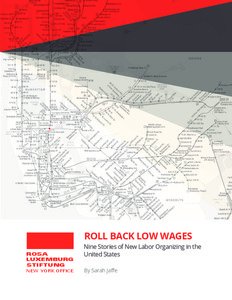Roll back low wages: nine stories of new labor organizing in the United States
"Precarity. If we were to select one word to best describe the most important current trend in the economy of the United States, “precarity” would be a leading candidate. In this study, labor journalist Sarah Jaffe, whose writing has appeared in The Washington Post, The Atlantic, The Guardian,...
| Main Author: | |
|---|---|
| Institution: | ETUI-European Trade Union Institute |
| Format: | TEXT |
| Language: | English |
| Published: |
New York
2015
Rosa-Luxemburg-Stiftung |
| Subjects: | |
| Online Access: | https://www.labourline.org/KENTIKA-19112830124919300129-Roll-back-low-wages-nine-stori.htm |
| Summary: | "Precarity. If we were to select one word to best describe the most important current trend in the economy of the United States, “precarity” would be a leading candidate. In this study, labor journalist Sarah Jaffe, whose writing has appeared in The Washington Post, The Atlantic, The Guardian, The Nation, and In These Times and who works as co-host of Dissent magazine’s Belabored podcast, examines this series of low-wage workers’ movements that has gained strength in recent years. Including fast food strikes and the fight for a $15 minimum wage; retail, grocery store, restaurant, and taxi workers; Carwasheros, domestic and home care workers, and those living in the U.S. under guestworker visas; Jaffe explores how these movements overlap and connect. She also analyzes their flaws and setbacks in order to better appreciate and learn how to reproduce their often-unreported victories. While, because of Washington gridlock, it might be a while before these campaigns impact federal legislation, they are already having a notable impact on policy in municipalities across the country: winning minimum wage increases; helping to pass employment-specific regulations and ordinances in cities and states that require businesses to give workers paid sick days; and forming legally recognized collective bargaining units and winning concessions from employers through direct action.
Perhaps more importantly, low-wage workers’ movements are playing a crucial role in revitalizing labor, and indeed much of the left, creating alliances and waging offensive battles at a time when too much of the progressive community has been stuck playing defense. They are doing everything they can to ensure that the defeat of precarity, and not its continuance, will be the most important trend in the U.S economy in the years to come." |
|---|---|
| Physical Description: | 25 p. Digital |

